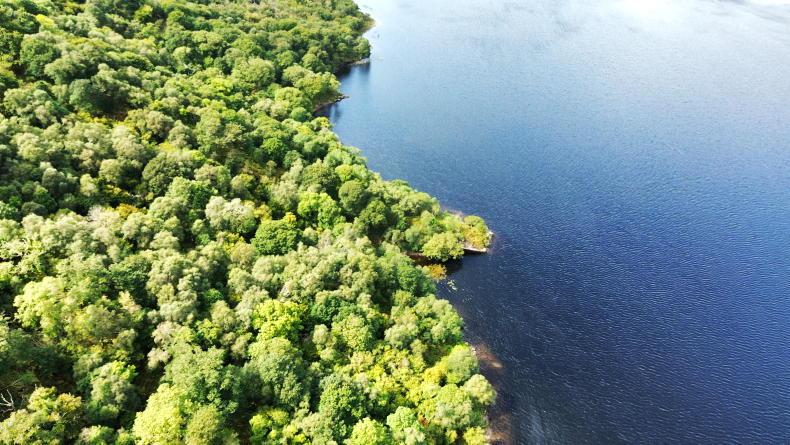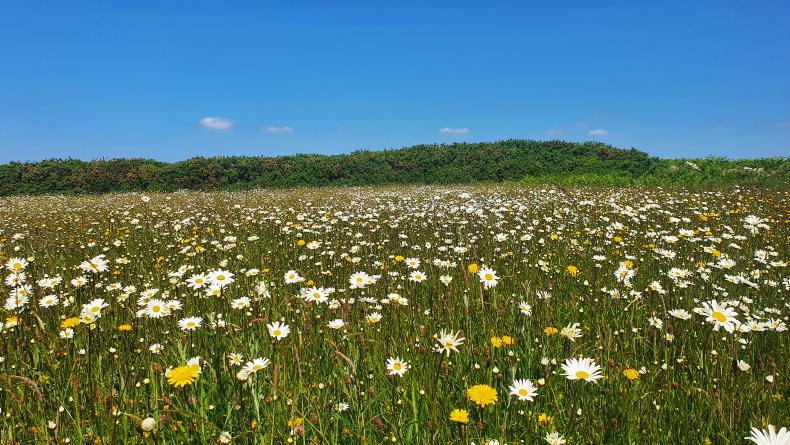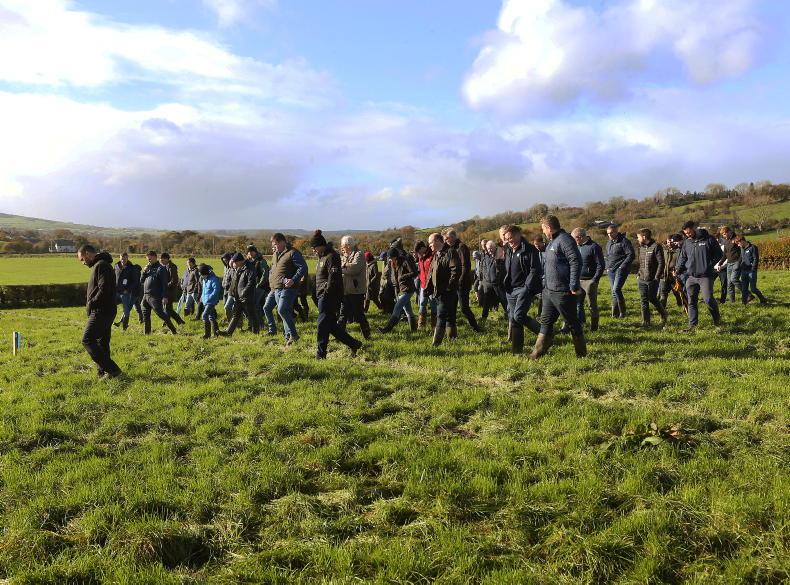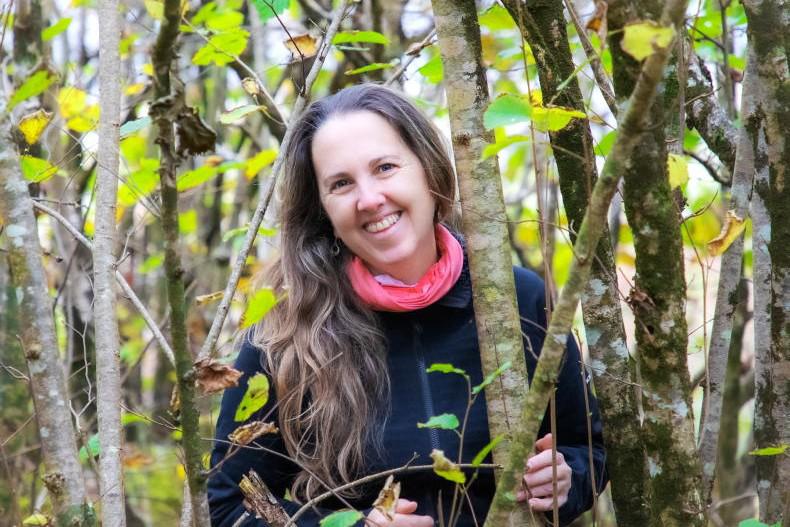Trees are often presented as a catch-all environmental solution, however, there are scenarios where they can negatively impact biodiversity.
A few years back, I was at a talkdown near Loop Head. It was with the well-known conservationist Barry O’Donoghue. He gave a gloomy bit of trivia that stuck with me.
He said: “When Packie Bonner saved the penalty against Romania in Italia ’90, Ireland had 4,000 breeding pairs of curlew. Today, it has less than 100 pairs.”
Around the time of that World Cup, Ireland was hitting its highest-ever afforestation rates, planting roughly 17,000 hectares (ha) a year between 1990 and 2000.
Of course, trees alone didn’t cause the dramatic decline of the curlew – many of the seminatural grasslands they require were also destroyed by agricultural intensification. Trees did, however, play a big role.

A native woodland. \ Ray Ó Foghlú
Much of what was planted at the time could be fairly described as “the wrong trees, in the wrong place”. These were mostly conifer monocultures on peatbogs, but, truth be told, native broadleaves would have had a similar effect.
Trees change habitats
Trees of all types fundamentally change habitats. They turn two-dimensional spaces into three-dimensional spaces. They create shade, they alter nutrient and water cycles, and they change the structure and biology of the soil.
These changes create niches for new species, but displace others that were there before.
Consider this scenario: a wet grassland, rich in devils-bit scabious, flag Iris, marsh orchid, wild mint and ragged robin. This is a superb habitat for a whole range of insects and birds.
Planting trees or allowing a woodland to naturally emerge here would destroy the habitat. Perhaps in a hundred years or so, the resulting forest would be an interesting habitat in its own right, but the grassland will be gone, as will all the species associated with it.
With this in mind, it’s worth noting that for Ireland to hit its 2035 woodland creation targets, around half of its wet grasslands will need to be afforested.
This issue of habitat displacement is one of the dominant concerns of agri-environmental schemes in the Burren.
Whilst the rest of the country struggles to create native woodlands, the farmers of the Burren are battling to keep them at bay.
Already way above the average at 18% woodland cover, there are serious concerns that important grassland habitat will be overwhelmed by the prolific spread of hazel scrub – a precursor to hazel woodland.

Planting trees in the wrong place can destroy really valuable habitats, so a lot of consideration is needed before making the decision. \ Ray Ó Foghlú
In the case of the curlew and other groundnesting birds (most of which have seen precipitous declines), habitat displacement has been a big driver of loss, but bigger again is the number of species which have made these new woodlands their home.
Forests provide habitats to a range of predators, including foxes, badgers and grey-backed crows. These predators raid nests and make easy pickings of eggs and juvenile birds.
Healthy ecosystems can accommodate such predation, but now the situation of Ireland’s groundnesting bird is critical, and the losses can’t be sustained.
Land use conflict
Undoubtedly, re-establishing woodlands – particularly native ones – is an important strategic objective for the State. Situating them appropriately on our landscape will be critical to ensuring they do the least damage and have the most positive impact.
Sadly, at farm-level, practical and economic realities can pitch woodland creation into competition with important existing habitats.

Ray Ó Foghlú, environmental scientist and woodland conservationist.
I ran a European Innovation Partnership (EIP) in west Clare, which involved working with local farmers, foresters and ecologists to create woodland integration plans for suckler farms.
Invariably, the first fields we would be taken to by the participating farmers were the least productive fields. Very understandable; but unfortunately, these wet, peaty or infertile pieces of ground were often the farms’ most biodiverse places.
In recent years, regulation has been introduced by the Forest Service to protect such places from the impact of trees.
This has been overwhelmingly a good thing, but at the level of implementation, these rules can be frustratingly lacking in nuance.
For example, across the west, we now have a situation in which places where old maps and place-names indicate the historical presence of forests, are now ineligible for woodland creation supports.
Without a change in mindset, this tension between where the State wants trees and where farmers want them will be a perennial issue.
Carefully consider where to plant trees
on your farm
The point of this article isn’t to diminish the biodiversity potential of trees – they still have much to offer, and in many, many situations, will add to local biodiversity rather than detract from it.
A few years back, I planted pockets of birch, alder, grey willow and sessile oak in a rushy field at home. I walked through them last week.
With the summer leaves gone, I could see that every couple of trees had a bird’s nest in it. As well as nests, the branches of each tree are now adorned with an array of crusty lichens; mosses now grow at their feet; curious-shaped galls cling to the alder and the oak; and an array of new fungi have emerged from the leaf-mold beneath them.
I would encourage every farmer to consider the potential for trees on their farm, but suggest asking this before deciding where to put them: “Is the area already rich in wildlife? Are there plants and insects in this area that you don’t see elsewhere on the farm?”
If the answer is yes, consider somewhere else, hard as it may be to do so.
Ray Ó Foghlú is an environmental scientist and woodland conservationist. He is the farm programmes co-ordinator with the Hometree charity. He recently completed a Nuffield scholarship on ‘Acquiring social licence to increase tree cover on the Irish landscape’.
Trees are often presented as a catch-all environmental solution, however, there are scenarios where they can negatively impact biodiversity.
A few years back, I was at a talkdown near Loop Head. It was with the well-known conservationist Barry O’Donoghue. He gave a gloomy bit of trivia that stuck with me.
He said: “When Packie Bonner saved the penalty against Romania in Italia ’90, Ireland had 4,000 breeding pairs of curlew. Today, it has less than 100 pairs.”
Around the time of that World Cup, Ireland was hitting its highest-ever afforestation rates, planting roughly 17,000 hectares (ha) a year between 1990 and 2000.
Of course, trees alone didn’t cause the dramatic decline of the curlew – many of the seminatural grasslands they require were also destroyed by agricultural intensification. Trees did, however, play a big role.

A native woodland. \ Ray Ó Foghlú
Much of what was planted at the time could be fairly described as “the wrong trees, in the wrong place”. These were mostly conifer monocultures on peatbogs, but, truth be told, native broadleaves would have had a similar effect.
Trees change habitats
Trees of all types fundamentally change habitats. They turn two-dimensional spaces into three-dimensional spaces. They create shade, they alter nutrient and water cycles, and they change the structure and biology of the soil.
These changes create niches for new species, but displace others that were there before.
Consider this scenario: a wet grassland, rich in devils-bit scabious, flag Iris, marsh orchid, wild mint and ragged robin. This is a superb habitat for a whole range of insects and birds.
Planting trees or allowing a woodland to naturally emerge here would destroy the habitat. Perhaps in a hundred years or so, the resulting forest would be an interesting habitat in its own right, but the grassland will be gone, as will all the species associated with it.
With this in mind, it’s worth noting that for Ireland to hit its 2035 woodland creation targets, around half of its wet grasslands will need to be afforested.
This issue of habitat displacement is one of the dominant concerns of agri-environmental schemes in the Burren.
Whilst the rest of the country struggles to create native woodlands, the farmers of the Burren are battling to keep them at bay.
Already way above the average at 18% woodland cover, there are serious concerns that important grassland habitat will be overwhelmed by the prolific spread of hazel scrub – a precursor to hazel woodland.

Planting trees in the wrong place can destroy really valuable habitats, so a lot of consideration is needed before making the decision. \ Ray Ó Foghlú
In the case of the curlew and other groundnesting birds (most of which have seen precipitous declines), habitat displacement has been a big driver of loss, but bigger again is the number of species which have made these new woodlands their home.
Forests provide habitats to a range of predators, including foxes, badgers and grey-backed crows. These predators raid nests and make easy pickings of eggs and juvenile birds.
Healthy ecosystems can accommodate such predation, but now the situation of Ireland’s groundnesting bird is critical, and the losses can’t be sustained.
Land use conflict
Undoubtedly, re-establishing woodlands – particularly native ones – is an important strategic objective for the State. Situating them appropriately on our landscape will be critical to ensuring they do the least damage and have the most positive impact.
Sadly, at farm-level, practical and economic realities can pitch woodland creation into competition with important existing habitats.

Ray Ó Foghlú, environmental scientist and woodland conservationist.
I ran a European Innovation Partnership (EIP) in west Clare, which involved working with local farmers, foresters and ecologists to create woodland integration plans for suckler farms.
Invariably, the first fields we would be taken to by the participating farmers were the least productive fields. Very understandable; but unfortunately, these wet, peaty or infertile pieces of ground were often the farms’ most biodiverse places.
In recent years, regulation has been introduced by the Forest Service to protect such places from the impact of trees.
This has been overwhelmingly a good thing, but at the level of implementation, these rules can be frustratingly lacking in nuance.
For example, across the west, we now have a situation in which places where old maps and place-names indicate the historical presence of forests, are now ineligible for woodland creation supports.
Without a change in mindset, this tension between where the State wants trees and where farmers want them will be a perennial issue.
Carefully consider where to plant trees
on your farm
The point of this article isn’t to diminish the biodiversity potential of trees – they still have much to offer, and in many, many situations, will add to local biodiversity rather than detract from it.
A few years back, I planted pockets of birch, alder, grey willow and sessile oak in a rushy field at home. I walked through them last week.
With the summer leaves gone, I could see that every couple of trees had a bird’s nest in it. As well as nests, the branches of each tree are now adorned with an array of crusty lichens; mosses now grow at their feet; curious-shaped galls cling to the alder and the oak; and an array of new fungi have emerged from the leaf-mold beneath them.
I would encourage every farmer to consider the potential for trees on their farm, but suggest asking this before deciding where to put them: “Is the area already rich in wildlife? Are there plants and insects in this area that you don’t see elsewhere on the farm?”
If the answer is yes, consider somewhere else, hard as it may be to do so.
Ray Ó Foghlú is an environmental scientist and woodland conservationist. He is the farm programmes co-ordinator with the Hometree charity. He recently completed a Nuffield scholarship on ‘Acquiring social licence to increase tree cover on the Irish landscape’.













SHARING OPTIONS